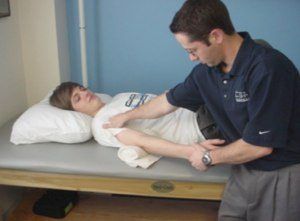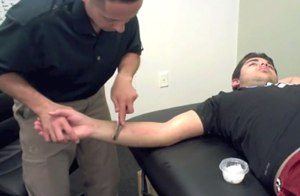With the baseball season almost officially in full swing, we are starting to see several players needing UCL reconstruction, or Tommy John surgery. We know that injuries are most common in the first month of the baseball season.
For those unfortunate to have injured their elbow, sorry to hear that. But luckily Tommy John surgery is fairly successful. With the right Tommy John rehabilitation, your should be able to return to pitching with minimal complications.
Knowledge is power, so in order to recover as best as possible, I want to education you on what I consider the keys to Tommy John rehabilitation. You should probably go back and read my past article on the 5 Myths of Tommy John Surgery as well. Follow these keys and put yourself in the best position to succeed.
Avoid Loss of Elbow Motion

Over the years we have progressed our rehabilitation program to focus on restoring full extension of the elbow a little faster. My goal is to have full elbow extension by 3-4 weeks if possible.
The key to this is early rehabilitation and finding a skilled physical therapist with experience in Tommy John rehab. Despite the media coverage that this surgery receives, in the grand scheme of things it is a relatively rare surgery so many therapists have never worked with one. A skilled therapist will know when to push and when to back off, you want them guiding you through this process.
It still amazes me that in this day and age, there are still surgeons who do not emphasize early rehabilitation. Take it upon yourself and make sure you don’t get behind with your motion.
Work on Imbalances During the Early Phases

To break this down, the first 4-6 weeks are focused on recovering from the surgery, reducing your pain and swelling, restoring your motion, and starting basic exercises.
The next two months consist of building back your strength, mobility, and stability. This involves shoulder program exercises and using those little dumbbells, slowly progressing week by week, Think of this phase as laying the foundation for more advanced exercises. It gets really monotonous laying those bricks down, but without them you are not going to have a good outcome or maximize your potential.
This is where I see most rehabilitation programs miss a huge opportunity to work on the some of the imbalances that likely led to you needing Tommy John surgery. These often include issues with your posture, core stability, and alignment of your scapula. This is a great time to work on those long standing soft tissue restrictions of the throwing arm. Manual therapy here is key.
Throwing a baseball places a lot of stress on your UCL ligament. But I often wonder if it is restrictions in your soft tissue, mobility, and strength from the shoulder, scapula, trunk, and core that placing the extra strain on your elbow that led to the injury. Use this time to get back to neutral so that way when you are ready to start throwing, you have put yourself in the best position to succeed.
Focus on the Shoulder and Scapula
Most of my athletes are amazed at how much my focus of rehabilitation is on the shoulder, scapula, trunk, core, and legs, and NOT the elbow. Don’t get me wrong, we do plenty of elbow work. The flexor carpi ulnaris and flexor digitorum superficialis muscles of the forearm lay directly over the UCL ligament and have been shown to provide 24% of the dynamic stability of the joint.
But the emphasis of any throwing athlete is often on the shoulder and scapula.
Think of the throwing motion as a wave of energy transferring from your legs, through your core, and eventually down your arm to the ball. Any restrictions or deficiencies in mobility, strength, or stability will cause an inefficient transfer of energy and often times your elbow takes that extra load. Most of the predisposing factors to injuring your UCL involve reduced strength and alterations in shoulder motion.
Integrate Core and Lower Body Training
Similar to emphasis on the shoulder and scapula, to really achieve optimal performance when you come back from Tommy John surgery, you must integrate proper core and lower body training. The above comments on the kinetic chain are applicable here too.
The days of just doing some treatments on the elbow and a few exercises for the shoulder are over. Proper rehabilitation programs must include attention to the core and legs to reach peak performance.
It’s Not Just About Strength

Equal attention must also be spent on restoring mobility and dynamic stability.
To throw a ball effectively, you must be strong and stable. Throwers tend to have laxity in their joints that allow them to bend and stretch further than most. This is extremely effective in making you a better pitcher with more velocity on your fastball. But it is also the reason why throwers get injured.
So we know that the joints of the elbow and shoulder have some underlying inherent instability. The must have pristine dynamic stability to counteract this.
Dynamic stability is simply your muscles ability to contract at the right time and intensity to stabilize your arm, and essentially prevent your arm from flying off your body. This is trainable, but it is difficult to do on your own. We perform a series of progressively advanced exercises to enhance your neuromuscular control and maximize your muscles’ ability to dynamically stabilize.
Don’t Skip or Rush Steps in the Progression
One of the flaws that I often see in athletes that come to me from a consult, but are rehabilitating elsewhere, is the expectation that the rehabilitation progression is simply a protocol and based on time. I often here, “It is week 16 and my doctor said I can start throwing.”
OK, sounds good, on the inside your UCL ligament is healed enough to throw in the doctor’s mind. But are you “ready” to throw?
What I mean is, do you look good on my examination? Did you restore your motion? Do you move well? Did you restore your strength? Do you exhibit proper dynamic stabilization?
Most importantly I always review their rehab program to date and assure that have went through the proper sequence. If you haven’t done the right program to date to prepare yourself to throw, you aren’t picking up a ball with me. I don’t care how weeks ago you had Tommy John surgery.
Use Your Throwing Program to Work on Your Mechanics

There are many mechanical faults that have been scientifically proven to increase stress on your UCL, such as throwing with and inverted W.
If you are serious about pitching, you need three key consultants on your team to help you achieve your goal, a physical therapist, a strength coach, and a pitching coach. Together, this team covers all your major bases for a strong and healthy return.
Your throwing progression is going to be long. Initially, I like you to just worry about throwing and playing catch, and NOT your mechanics. But this switch flips once we get closer to pitching and throwing off a mound. Create good habits early and work with a pitching coach on some of the mechanical factors that may have led to your Tommy John injury in the first place.
Follow a Slow and Gradual Throwing Progression
Many times people have a really good comeback from Tommy John surgery during the rehab process, but have issues during their throwing program. Here is an important thing to consider:
There are going to be bumps in the road.
I usually see these bumps at the transition points such as when you start long toss, or when you start throwing off a mound. Any time you have a jump in intensity or volume, this may occur. These are common and expected. If you put in the proper effort and progression to date, you have put yourself in position to successfully deal with these events.
The key is to avoid a roller-coaster progression of speeding-up, slowing-down, and speeding-up again. A slow and gradual progression is always best.
I’m going to let you in on a very super secret that most doctors and therapists do not want you to know. Your are probably going to feel great about 1-2 months into your throwing program and think you can throw 100 mph.
Resist this urge. You are not ready and you will flare up your elbow (or even shoulder).
Please, please, please do not rush back to returning to pitching, especially for the youth and parents reading this. Yes, our research has shown that pitchers return to throwing at 9-12 months following surgery. Realize there are a large variety of people in a study like this. Many of my MLB pitchers have return in 10-11 months, especially the veterans. There are a lot of factors in determining this return date.
But I do not even feel good about a veteran all-star returning at 9 months after Tommy John surgery, let alone a 16 year old. For the youth and even collegiate pitchers, a good timeframe to shoot for is 12 months. Do it right the first time.
SEE ALSO: Watch my full presentation on the Keys to Tommy John Rehabilitation
With the right care and attention, UCL reconstruction surgery can have a really good outcome. Follow these 8 keys to Tommy John Rehabilitation and you’ll be back on the mound in no time.





